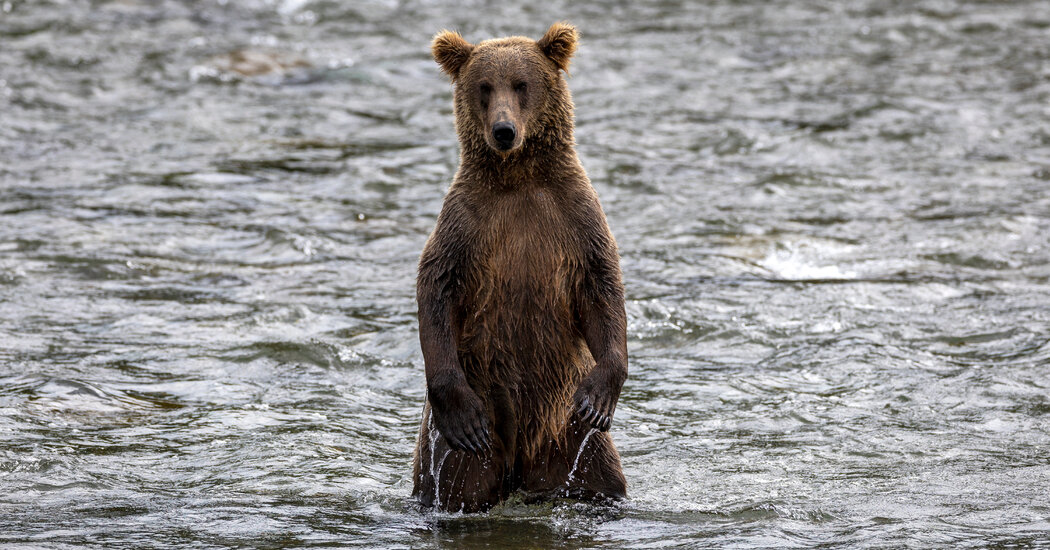In August, a black bear bit a man who was camping in Colorado, officials released a statement about “bear activity” in Tennessee after one tried to find food in a car, and a grizzly attacked a man in Wyoming.
In September, a black bear and her cubs ate Krispy Kreme doughnuts in Alaska, another black bear prompted closures at Walt Disney World in Florida, and officials in Montana euthanized a grizzly who had broken into a home and fatally attacked a woman earlier in the summer.
And beginning on Wednesday, Fat Bear Week, an annual contest to crown a champion among the hundreds of hefty bears of Katmai National Park and Preserve in Alaska, will offer delight on many people’s newsfeeds.
So, what’s going on?
Part of the reason stories about bears have been so unavoidable over the past few months is that in some places, including in Montana and Florida, the populations of both bears and humans have increased in recent years, leading to more encounters. The ever-growing presence of social media and the meteoric rise of TikTok have also played a major role.
“There’s a collision of factors that might make you feel as though bears are absolutely everywhere,” said Emily Bell, the director of the Tow Center for Digital Journalism at Columbia University. “Fat Bear Week was not a thing that anyone talked about five or 10 years ago.”
The time of year is one such factor. There are more interactions between humans and bears in late summer and early fall, said Greg Lemon, a spokesman for Montana’s Fish, Wildlife and Parks Department, because bears are searching for food before winter and humans are out hunting.
More people have also been exploring places that were previously less popular but have gained fame on social media, said Deion Broxton, a broadcast news reporter at KMOV in St. Louis who used to cover Yellowstone National Park. One such place is Glacier National Park in Montana, where a grizzly bear was seen hiking among humans this summer.
Grizzlies have been federally protected since the 1970s, and their population is growing. Wyoming petitioned last year to remove grizzly bears around Yellowstone from the endangered species list, with support from Montana and Idaho. The U.S. Fish and Wildlife Service is reviewing the matter.
“Every year, there are more of them and more of us,” Mr. Lemon said.
It’s not just that there are more bear-human interactions in some places. It’s also that we’re hearing about them again and again. Bears and their antics are perfect fodder for short video clips (like this bear politely closing a front door, this one grabbing snacks from a 7-Eleven and this bear showing up at to a picnic). And once you watch one bear video, social platforms’ algorithms may serve you a perpetual supply of them.
News organizations are also struggling to recapture the large audiences who flocked to Covid-related news, Ms. Bell said. Bear stories often bring a lot of readers.
Anytime Mr. Lemon, at Montana’s Fish, Wildlife and Parks Department, writes a news release about a bear interacting with a human, he said, “‘The Today Show’ is calling — it’s just nuts.” Since June, “The Today Show” has run at least four items about bears. (The New York Times is no exception — we published at least seven articles about bears this summer, not including this one.)
Mr. Broxton, the broadcast news reporter, said that he saw an audience demand for “wholesome” content about animals, and that he knew videos showing interactions with humans would get noticed.
“We look for anything that grabs people’s attention,” said Mr. Broxton, who had his own close encounter with wild animals — bison — that went viral in 2020.
The media attention can feel reminiscent of what came to be known as “the Summer of the Shark” in 2001, when news outlets relentlessly covered shark attacks in Florida, the Bahamas and elsewhere. At the time, scientists said that fears of such incidents were overblown.
News organizations that report on wildlife encounters or animal attacks should provide enough information and context for the public to understand the risk, said Ted Spiker, the chair of the University of Florida’s journalism department. Reporters covering these stories, he said, should ask: “What’s the bigger picture? What are the reasons for the increase?”
One of the downfalls of the short videos is that they don’t teach people anything, said Michael Orlando, the head of the bear management program at Florida’s Fish and Wildlife Conservation Commission, who has been working with bears since 1996.
“It’s more entertainment than educational,” he said.
He added that he had one consistent message for the public: “Please don’t intentionally or unintentionally feed bears. It never works out for the bear.”











